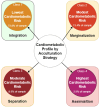Profiles of cardiometabolic risk and acculturation indicators among South Asians in the US: latent class analysis of the MASALA study
- PMID: 39440183
- PMCID: PMC11495395
- DOI: 10.3389/fpubh.2024.1384607
Profiles of cardiometabolic risk and acculturation indicators among South Asians in the US: latent class analysis of the MASALA study
Abstract
Background: South Asians (SA) represent the fastest growing US immigrant group, and previous studies have indicated that they face disproportionately high burden of cardiometabolic disease. Cardiometabolic disease manifests as a syndemic or synergistic epidemic encompassing multiple disease clusters influenced by biological, social, and psychological factors stemming from the acculturative process. This process may exacerbate morbidity within immigrant subgroups. Our aim was to identify cardiometabolic risk profiles among SA using indicators of acculturation.
Methods: We conducted a latent class analysis on data from the Mediators of Atherosclerosis in South Asians Living in America study (N=771). A composite cardiometabolic disease outcome was constructed using prevalent hypertension, type 2 diabetes, and body mass index. Acculturation indicators included years living in the US, English language proficiency, dietary behaviors, preservation of cultural traditions, social and neighborhood support, maintenance of social relationships (i.e., friendships), and experiences of discrimination, along with proxies of acculturative stress (i.e., depressive symptomology, trait anxiety and anger). Social and environmental determinants of health, health behaviors, religiosity and spirituality served as covariates to further assess latent class membership.
Results: Four cardiometabolic risk profiles emerged: (1) lowest risk [73.8% of sample] characterized by high integration into both SA and US cultures; (2) the modest risk [13.4% of sample], exhibiting elevated levels of mental health distress and experiences of discrimination, and distancing themselves from both cultures; and the (3) moderate risk [8.9% of sample] and (4) highest risk [3.9% of sample], demonstrating greater assimilation into US culture. Compared to the lowest risk profile: the modest risk profile was associated with low-income and conflicting attitudes about religion/spirituality, while the moderate risk profile was characterized by lower income and educational attainment with positive behaviors and attitudes toward religion/spirituality.
Conclusion: Findings expand our understanding of immigrant cardiometabolic health as a syndemic issue wherein multiple co-occurring and interacting processes synergize to produce negative outcomes in already at-risk subpopulations. Furthermore, acculturation emerges as a crucial factor in understanding health disparities among immigrant and refugee groups in the US.
Keywords: South Asian; acculturation; cardiometabolic disease; latent class analysis; social determinants of health.
Copyright © 2024 Montiel Ishino, Canenguez, Cohen, Kent, Villalobos, Needham, Kandula, Kanaya, Shields and Williams.
Conflict of interest statement
The authors declare that the research was conducted in the absence of any commercial or financial relationships that could be construed as a potential conflict of interest.
Figures




Similar articles
-
Acculturation Strategies and Symptoms of Depression: The Mediators of Atherosclerosis in South Asians Living in America (MASALA) Study.J Immigr Minor Health. 2018 Aug;20(4):792-798. doi: 10.1007/s10903-017-0635-z. J Immigr Minor Health. 2018. PMID: 28748299 Free PMC article.
-
Acculturation Strategies Among South Asian Immigrants: The Mediators of Atherosclerosis in South Asians Living in America (MASALA) Study.J Immigr Minor Health. 2017 Apr;19(2):373-380. doi: 10.1007/s10903-016-0372-8. J Immigr Minor Health. 2017. PMID: 26928020 Free PMC article.
-
The relationship of acculturation to cardiovascular disease risk factors among U.S. South Asians: Findings from the MASALA study.Diabetes Res Clin Pract. 2020 Mar;161:108052. doi: 10.1016/j.diabres.2020.108052. Epub 2020 Feb 26. Diabetes Res Clin Pract. 2020. PMID: 32113027 Free PMC article.
-
The social determinants of health associated with cardiometabolic diseases among Asian American subgroups: a systematic review.BMC Health Serv Res. 2022 Feb 25;22(1):257. doi: 10.1186/s12913-022-07646-7. BMC Health Serv Res. 2022. PMID: 35216607 Free PMC article.
-
Cardiovascular Risk Factors Among Asian Americans: Perspectives on the Role of Acculturation in Cardiovascular Diseases Health Disparities.J Immigr Minor Health. 2024 Apr;26(2):409-420. doi: 10.1007/s10903-023-01489-y. Epub 2023 May 24. J Immigr Minor Health. 2024. PMID: 37222869 Review.
Cited by
-
Prevalence of diabetes distress among people with type 2 diabetes in South Asia: A systematic review and meta-analysis.World J Diabetes. 2025 Aug 15;16(8):109352. doi: 10.4239/wjd.v16.i8.109352. World J Diabetes. 2025. PMID: 40837336 Free PMC article.
References
-
- Santos Volgman A, Palaniappan LS, Aggarwal NT, Gupta M, Khandelwal A, Krishnan AV, et al. . Atherosclerotic cardiovascular disease in South Asians in the United States: epidemiology: epidemiology, risk factors, and treatments: a scientific statement from the American Heart Association. Circulation. (2018) 138:e1–e34. doi: 10.1161/CIR.0000000000000580 - DOI - PubMed
-
- Zhou B, Carrillo-Larco RM, Danaei G, Riley LM, Paciorek CJ, Stevens GA, et al. . Worldwide trends in hypertension prevalence and progress in treatment and control from 1990 to 2019: a pooled analysis of 1201 population-representative studies with 104 million participants. Lancet. (2021) 398:957–80. doi: 10.1016/S0140-6736(21)01330-1, PMID: - DOI - PMC - PubMed
MeSH terms
Grants and funding
LinkOut - more resources
Full Text Sources

